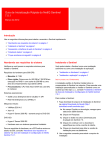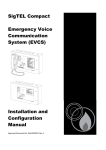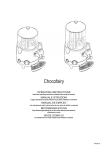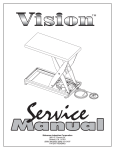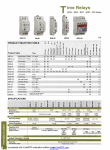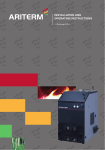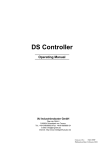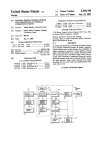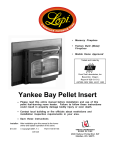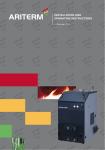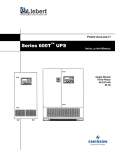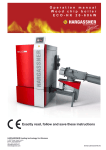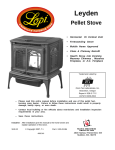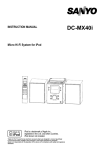Download service manual - Arcade
Transcript
=7:~NEL SERVICE MANUAL I 2 1.0 2.0 3 3.0 4.0 I 4.1 4.2 General Description General Description The Sentinel coin mechanism is the first of a new family of products based on Coin Controls’ new cash handling concept of Flexible Cash Modules. Interface Connections It uses the latest in coin handling technology to offer a product with an Sentinel Mechanical Description unparalleled combination of performance, features and value for money. Factory Fitted Coin Entry and The key feature of Sentinel is flexibility. By selection from the carefully exit options designed system of mechanical sub-modules, Sentinel can be configured to suit any 5” size coin mechanism application. Front Entry Sentinel Versions 30 and 35 4.3 Top Entry Sentinel Exploded diagram 5.0 Coin Sorting 5.1 Corn Sorter Module 5.2 Removal and Replacement of Sentinel has the following features:Standard 5” size Up to 8 coin validation Industry standard parallel interface with automatic selection IIC serial communication port Sorter 6.0 Mechanisms Internal Access Mechanism Removal and installation in Machine Electrical Interface Specification Field programmability of active 4 way sorter routing. Corn output configuration compatible with existing AWP’s when one of two optional manifolds are fitted. Power Supply Parallel Interface Using the Parallel Interface I Routine Maintenance 1 1.0 On Site Testing I VERSIONS 2.0 S entinel Versions 30 and 35 T here are two versions of the Sentinel 30 series of coin acceptors. These are the Sentinel 30, which does not h ave a sorter, and the Sentinel 35 which has a full 4 way active sorter fitted. B oth versions are available with either Front Entry or Top Entry options. The Front Entry option is available with direct or indirect reject the Top Entry being available with Indirect reject only. T he versions in common usage are shown in Figures I to 5 below. F IGURE I SENTINEL 30 TOP ENTRY Thls shows the Top Entry version without the active sorter, for back channel mounting. This version may be used in Juke Boxes and vending applications where no coin sorting for payout is required and where front panel space IS II mited. TopEntry Accept Outlet Reject FIG 2. FIGURE 2 SENTINEL 35 TOP ENTRY T h i s shows the Top Entry version fitted with the a c tive 4 way sorter, which may be site programmed. Applications for this version include vending with change. FIG 3. 30 FRONTPLATE, INDIRECT REJECT IGURE 3 SENTINEL This is the Front Entry version without the active orter, and may be in either direct or indirect machine) reject options. Applications for this version Include Juke boxes, Vending and Video nachines where front panel space is avaliable. FIG 4. 35 FRONTPLATE. DIRECT REJECT FIGURE4 SENTINEL This is the Front Entry version fitted with the active 4 way sorter, and may be in either direct or Indirect (machine) reject options. Applications for this version Include AWP, SWP and vending with change. \ ’ FIG 5. 35 FRONTPLATE. INDIRECT + MANIFOLD FIGURE 5 SENTINEL This the Front Entry version with active 4 way sorter fitted, with the addltlon of a manifold.Thls version will be found in current AWP and SWP machines. This version is available in in dlrect reject only.Two versions of the manifold are available and are shown in figure 6. FIG 6. Manifold 5 and 6 configurations MANIFOLD 5 I MANIFOLD 6 SENTINEL EXPLODED DIAGRAM FIG 7 Parts List I Coin entry and button housing 2 Button 3 Button lid 4 Button cone spring 5 Button label 6 Quick release latch 7 Main body 8 M4.0 x 16.0 pozi pan HD screw 9 Front entry gate piece IO Gate snubber I I 4.20 x 3/8" pozi CSK screw I2 Quick release latch spring I3 Front entry 14 2nd sense coil assembly 15 Bulb I6 Lamp holder 17 M4.0 full nut I 18 I st sense coil assembly 19 4.20 x 5/16" pozi pan HD 20 3rd sense coil 21 Main body pole piece 22 P.C.B. cover plate 23 Solenoid assembly 24 Hinge pin spring 25 Main body snubber 26 Hinge pin 27 Sorter coin diverter flap 28 Final accept coil assembly 29 Printed circuit board assembly 30 4.20 x 5/8 pozi pan HD screw 3 I Sorter centre plate 32 Coin diverter flap spring 33 Sorter solenoid flap 34 Solenoid flap pole piece 35 6.20 x 1/4" pozi pan HD screw 36 Solenoid coin flap assembly 37 Sorter solenoid cone spring 38 Sorter solenoid cover 39 Coin rundown and reject cover 40 Accept gate 41 Accept gate spring 42 Reject gate 43 Mech. mounting studs 44 Front plate 45 M3.0 x 6.0 pozi pan HD screw 46 Cotton catch 47 Photo Cells 51I Top entry chute 52 Top entry gate piece 53 Top entry reject lever 54 Top entry reject lever pivot screw 55 Top entry reject lever spring 56 Reject cup 57 Reject cup flap 58 M3.0 x pozi pan HD 59 Single corn outlet I 5.0 C oin Sorting Coin sorting is performed by the optional four way plug in active sorter. Coin sorting is fully flexible (any coin any way) and is programmed by values STORED IN SENTINEL EEPROM IN THE COIN VALIDATOR A SSEMBLY. There are six coin sorting functions which may each be programmed to any of the eight coin channelsCoin always diverted down sorter path A’ Coin always diverted down sorter path B C oin always diverted down sorter path C Coin always diverted down sorter path D C oin toggles alternately down sorter paths A & B C oin toggles alternately down sorter paths C & D VIEW FROM BOTTOM OF MECH FIG 8. T he last two sorter functlons are lntended for club machlnes or any application where two pay out devices for the same coin value are required. 5. I Coin Sorter Module When fitted to the assembly the sorter allows four way sorting. This is achieved by two Integral flaps (27,36) which are actively driven by two solenoids(23B,23C). The first flap (36) is a metal Construction, which diverts the coin to one of the ports A or B at the back of the assembly when the solenoid(23C) is not energised , and to 0 ne of the ports C or D near the centre of the mechanism when the solenoid is energised. The long plastic diverterflap (27)which runs the length of the sorter is used to select between ports A and B or between ports C and D under the control of the solenoid (23B). Two sets of photo cells(47) are located at the bottom of the sorter, which reset the solenoids and allow the assembly to accept further coins immediately after the coin has cleared the cells. This eliminates any timing complication. The default path of the sorter (i.e. no solenoids energised) is path A. With reference to the sorter output paths diagram it can be seen that if a solenoid fails to operate, it will cause a coin to tend toward the A side of the sorter i.e. Top solenoid fail will cause coins from C to go down A and D to go down B. similarly if the bottom solenoid falls, coins from B will go down A, and coins from D go down C. The sorter paths are programmed into the Sentinel validator assembly on manufacture to the customer requirements Note that replacement of a sorter does NOT require any reprogramming, but that replacment of the complete mech MUST be with one with the same sorter paths (as shown on the mech I abel). The Sentinel may be reprogrammed for other coin paths using the Sentinel Toolkit. 5:2 I Removal and Replacement of Sorter The sorter can be unplugged once the cover and snubber are removed -see Mechanism Internal Access 6.0. When reassembling a sorter onto the mechanism body ensure that the diverter flap (27) does not become trapped between the sorter body and the mechanism. This is most easily ensured by offering the mechanism I body down onto the sorter module. Ensure that the 4 connector pins are al igned correctly with the sockets in the mechanism body. Once the sorter is fitted correctly, refit the snubber (25) and cover (39), securing with screw (I 9C). 6 6.0 Mechanism Internal Access 1 to parts required for on site service is by removal of the screw (I 9C). Note the position of the metal nubber (25), and ensure that it is refitted correctly on reassembly of the mechanrsm. Mechansim Removal and installation in Machine To remove the body from the front plate, disconnect any serial or parallel Interface connectors Hold the mechanism across the top, and pull the locking catch (6) toward you with one finger. Raise the mechanism as far as it will go without pulling the mechanism toward you. withdraw the mechanrsm by pulling gently toward the -ear of the machine. Note thatthere is no sldeways movement in removing the Sentinel acceptor. lnstallation IS he reverse of removal, except that the locking bar will engage automatically when the acceptor is properly located. Electrical ELECTRICAL SPECIFICATION POWER SUPPLY REQUIREMENTS Interface Specifications IMPORTANT NOTE Application of signals or voltages outside specification may cause damage to or malfunction 8.1 Power of the mechanism Supply Voltage: I I to 15 volts DC Current: 220 mA continuous. 0.7 A maximum (no sorter fitted) 2.0 A rnaximum (with sorter fitted) Rise time: 200 rnsec maximum It is important to ensure sufficient power supply current capacity. A minimum capacitance of 4700 microfarads IS recommended on the machine power supply output rail. 8.2 Parallel Interface COM A: +5 to +20V DC, -5 to -20V DC 200 mA maximum Al to A4: 8 mA source at COM A = +5V 50 mA source at COM A = +9V to •t 24V 20 mA sink at COM A = --5V SO mA sink at COM A = -I0V to -20V Pulse length + 80msec +/- 20% 9.0 I I to I7,8: Internal pull up to 5V DC Open circuit or > 3.6V = inhibit Short circuit to OV or < I .2V = accept SELECT internal pull up to 5V Open circuit or > 3.6V = 4 coin Short circuit to OV or < I .2V = 8 coin Using the Parallel Interface The parallel Interface provides open collector output signals which will automatically to COM A and select pull up or pull down output drives as required. All parallel interface signals are routed via connector I, and the following signals Pin No. Signal Name Signal Description Supply input for accept output drive 1 COM 4 2 Al Accept output Coin I 3 NC Polarising position 4 A2 Accept output Coin 2 5 A3 Accept output Coin 3 6 Select 4 coin/8 Coin select line 7 A4 Accept output Coin 4 8 14 9 10 v supply 0 volts Inhibit acceptance Coin 4 Power supply Input Machine 0 volts supply 13 Inhibit acceptance Coin 3 12 12 Inhibit acceptance Coin 2 13 II Inhibit acceptance Coin 14 15.6 Inhibit acceptance Coins 5 and 6 15 17.8 Inhibit acceptance Coins 7 and 8 1I 7 1 sense the voltage applied are available on this connector outine Maintenance T h e plastic coin run down should be cleaned periodically Access to the run down is gained by folding back the reject flap and removal of the screw (19C) and cover (39). Note the position the snubber (25) and ensure it is refitted correctly on reassembly. Remove the sorter module described - see COIN SORTER MODULE. Cleaning of the sorter module may then also be carried out. T h e cleaning materials recommended for the Sentinel Corn acceptor are as follows:- Mild detergents and water, using a damp cloth. Foam cleaners providing they are not acetone based. under no circumstances should any acetone or ketone based cleaners be used on the acceptor - sorter. Silicone spray polishes should never be used as these will reduce the static protection corporated in the acceptor plastic 11.0 On Site Testing before replacement of the mechanism, please check the following pointsMechanisim correctly installed in Front Plate/Back Channel. Gate assembly correctly closed Mechanism rundown not obstructed Corns not backed up into the mechanism from underneath Mechanism rundown is clean-see Routine Maintenance Symptom Mech does not work ( a l l coins reject) Investigate Possible Cause Connector Poor contact Bent pins Power supply + 12V NOMINAL + I IV MINIMUM Not switched on Incorrect voltage NOTF Supply voltage must not drop below this absolute minimum. A meter may not detect transients that may occur on acceptance of a coin Use of the Toolkit advised. 30 Inadequate power 700mA 35 2A Power supply Rise 200mSec max Time too slow Inhibits inputs > I .2V for ACCEPT Accept Gate Mech takes first coin and then stops working True coin reject too often Coins stick or jam in mech Mech inhibited Gate not free or dislocated Accept Channel Obstruction in Channel Parallel parallel/ Interface Interface - 20V to 0v +5v to +24v COM A pin not connected. Voltage out of limits Serial Interface (If connected) Host Machine not responding Power supply 11-15v Voltage out of specification Accept Gate Flap not free or dislocated Connector Loose Rundown Dirty Sorter opto detectors 35 only Failed Mech times out after 2 seconds, giving poor accept rate when coins are fed fast, but is alright when fed at I coin/3 seconds. Rundown Accept channel Reject channel Accept Gate Sorter (If fitted) Dirt or mechanical damage/obstruction Mounting of mech Body and/or sorter Improperly mounted 8 One of the true coins always r ejects (if connected) Coins I” wrong .ashbox No accept signal dent or broken connection pin < 1.2v I for accept Wrong inhibit input voltage < I 1.6V = ACCEPT Accept Flap spring loose or flap dislocated flap Sorter Dirty, mechanical damage or obstruction Solenoid failure or wire broken Connector Accept channel Connector loose or broken Dirty or obstructed f any of the defects cannot be rectified, then the mechanism ame sorter paths as shown on the faulty mech label should be replaced with one programmed to the Return the faulty acceptor to Coin Controls for repair. We do not recommend that any rectification attempted on the main electronics assembly. The mechanism warranty. is covered by a warranty from Coin Controls and unauthorised For spares and service rectification is may invalidate this contact Coin Controls Technical Sales Department. Telephone: 06 I -678 0 I I I. 9











